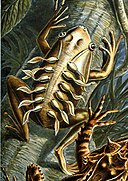Датотека:Haeckel Batrachia.jpg

Величина овог приказа: 424 × 599 пиксела. 5 других резолуција: 170 × 240 пиксела | 339 × 480 пиксела | 543 × 768 пиксела | 724 × 1.024 пиксела | 2.323 × 3.284 пиксела.
Оригинална датотека (2.323 × 3.284 пиксела, величина датотеке: 2,17 MB, MIME тип: image/jpeg)
Историја датотеке
Кликните на датум/време да бисте видели тадашњу верзију датотеке.
| Датум/време | Минијатура | Димензије | Корисник | Коментар | |
|---|---|---|---|---|---|
| тренутна | 05:17, 24. фебруар 2006. |  | 2.323 × 3.284 (2,17 MB) | Ragesoss | improve version, based on same original scan |
| 02:22, 11. фебруар 2006. |  | 2.318 × 3.280 (2,21 MB) | Ragesoss | The 68th plate from Ernst Haeckel's 1899 ''Kunstformen der Natur'', depicting frogs classified as Batrachia. Category:Ernst Haeckel |
Употреба датотеке
Следећа страница користи ову датотеку:
Глобална употреба датотеке
Други викији који користе ову датотеку:
- Употреба на arz.wikipedia.org
- Употреба на ast.wikipedia.org
- Употреба на az.wikipedia.org
- Употреба на ban.wikipedia.org
- Употреба на be.wikipedia.org
- Употреба на bg.wikipedia.org
- Употреба на ca.wikipedia.org
- Употреба на ca.wikibooks.org
- Употреба на ceb.wikipedia.org
- Употреба на ckb.wikipedia.org
- Употреба на dag.wikipedia.org
- Употреба на de.wikipedia.org
- Употреба на din.wikipedia.org
- Употреба на el.wikipedia.org
- Употреба на en.wikipedia.org
- Wikipedia:Featured pictures thumbs/04
- Wikipedia:Picture of the day/June 2006
- User:Ragesoss/Haeckel
- Wikipedia:Featured picture candidates/Haeckel Batrachia.jpg
- Wikipedia:Wikipedia Signpost/2006-03-13/Features and admins
- Wikipedia:Featured picture candidates/March-2006
- Talk:Frog/Archive 3
- User talk:Ragesoss/Archive1
- Wikipedia:Picture of the day/June 12, 2006
- Wikipedia:POTD/June 12, 2006
- Wikipedia:POTD column/June 12, 2006
- Wikipedia:POTD row/June 12, 2006
- Kunstformen der Natur
- User:Samsara/Frog/Stable
- User:RichardF/POTD
- Wikipedia:WikiProject Germany/Gallery
- User talk:RichardF
- User:Froggyyes~enwiki
- Wikipedia:Featured pictures/Animals/Amphibians
- Unclean spirit
- User:Xophist/s5
- Wikipedia:Wikipedia Signpost/2006-03-13/SPV
- Talk:Alfred Russel Wallace/Archive 1
- Portal:Amphibians/Selected picture
- User:The Transhumanist/Sandbox144
Још глобалног коришћења ове датотеке.






